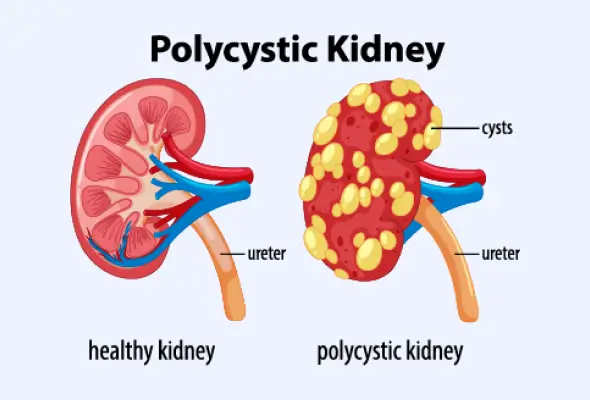-
Doctors
-
Specialities & Treatments
Centre of Excellence
Specialties
Treatments and Procedures
Hospitals & Directions HyderabadCARE Hospitals, Banjara Hills CARE Outpatient Centre, Banjara Hills CARE Hospitals, HITEC City CARE Hospitals, Nampally Gurunanak CARE Hospitals, Musheerabad CARE Hospitals Outpatient Centre, HITEC City CARE Hospitals, Malakpet
HyderabadCARE Hospitals, Banjara Hills CARE Outpatient Centre, Banjara Hills CARE Hospitals, HITEC City CARE Hospitals, Nampally Gurunanak CARE Hospitals, Musheerabad CARE Hospitals Outpatient Centre, HITEC City CARE Hospitals, Malakpet Raipur
Raipur
 Bhubaneswar
Bhubaneswar Visakhapatnam
Visakhapatnam
 Nagpur
Nagpur
 Indore
Indore
 Chh. Sambhajinagar
Chh. SambhajinagarClinics & Medical Centers
Book an AppointmentContact Us
Online Lab Reports
Book an Appointment
Consult Super-Specialist Doctors at CARE Hospitals

Polycystic Kidney Disease
Symptom, Causes, Diagnosis and Treatment
Polycystic Kidney Disease
Polycystic kidney disease affects millions globally, making it one of the most common inherited kidney disorders. From medication and lifestyle changes to specialised procedures, doctors can now offer various approaches to manage symptoms and protect kidney function. Understanding how polycystic kidney disease affects overall health is the first step toward making informed decisions about care and treatment options.

What is Polycystic Kidney Disease?
Polycystic kidney disease (PKD) is a genetic disorder characterised by the development of multiple fluid-filled sacs called cysts in the kidneys. Unlike simple kidney cysts that might develop with age, PKD cysts can significantly alter both the shape and size of the kidneys, leading to serious health complications.
The condition causes the kidneys to enlarge as these cysts grow and multiply over time. The nature of PKD makes it particularly concerning, as it gradually reduces the kidneys' ability to filter waste from the blood. The cysts in PKD have several distinct characteristics:
- They can vary significantly in size
- They contain fluid and continue to grow larger
- They can develop in both kidneys simultaneously
- They can affect other organs, particularly the liver and pancreas
PKD is classified as a form of chronic kidney disease that can eventually progress to kidney failure if left unmanaged. The severity of the condition varies among people, with some experiencing mild symptoms while others face more serious complications. While the primary impact is on the kidneys, PKD can affect multiple body systems, potentially causing high blood pressure and complications with blood vessels in the brain and heart.
Types of Polycystic Kidney Disease (PKD)
Doctors classify polycystic kidney disease into two distinct types, each with unique characteristics and patterns of inheritance.
- Autosomal Dominant Polycystic Kidney Disease (ADPKD): ADPKD represents the most common form, affecting approximately 9 out of 10 people with PKD. This type typically develops between ages 30 and 40, though cysts may begin forming much earlier. ADPKD occurs when a person inherits one copy of the altered gene from either parent, giving each child of an affected parent a 50% chance of developing the condition.
- Autosomal recessive Polycystic Kidney Disease (ARPKD): ARPKD is far less common, affecting approximately 1 in 20,000 to 40,000 individuals. This form appears early in life, often affecting newborns or young children. Both parents must carry the PKHD1 gene mutation for a child to develop ARPKD.
The key differences between these types include:
- Prevalence: ADPKD affects 1 in 400 to 1,000 people, while ARPKD is much rarer
- Age of Impact: ADPKD symptoms typically appear in adulthood, while ARPKD manifests in infancy or early childhood
- Organ Involvement: ARPKD commonly affects both kidneys and liver, while ADPKD primarily impacts the kidneys
- Disease Progression: ARPKD typically shows more severe symptoms earlier in life compared to ADPKD
- Survival Rate: ADPKD patients often live into adulthood, while ARPKD can be life-threatening in infancy
Symptoms of Polycystic Kidney Disease
Patients may experience various physical manifestations. These symptoms can include:
- High blood pressure stands out as the most common early indicator of the condition
- Back or side pain, particularly in the lower back
- Blood in the urine (haematuria)
- Increased size of the abdomen due to enlarged kidneys
- Frequent bladder or kidney infections
- A feeling of fullness in the belly
- Headaches related to high blood pressure
- Kidney stones
- Heart-related symptoms, including a fluttering or pounding sensation in the chest
Causes and Risk Factors of Polycystic Kidney Disease
Genetic mutations lie at the heart of polycystic kidney disease, with specific genes playing crucial roles in its development. Scientists have identified mutations in three primary genes, PKD1, PKD2, and PKHD1, which affect the normal development and function of kidney cells.
Several factors increase the risk of developing or experiencing complications from polycystic kidney disease:
- Strong family history of the condition
- Age progression, particularly in cases of simple cysts
- Long-term dialysis treatment
- Maternal inheritance, which often leads to increased disease severity
- Presence of specific gene mutations
While most cases of polycystic kidney disease stem from genetic causes, some individuals develop an acquired form. This variation, known as acquired polycystic kidney disease, typically occurs in people who have undergone hemodialysis treatment for several years due to other kidney conditions.
Complications of Polycystic Kidney Disease
The most significant complications include:
- Cardiovascular Problems: Nearly all individuals with PKD develop high blood pressure, which can result in heart disease and stroke. This condition requires attentive monitoring and management to prevent further kidney damage. Heart valve abnormalities occur in about 25% of individuals with polycystic kidney disease and develop a condition known as a "floppy valve" in the heart.
- Brain Aneurysms: Approximately 10% of people with PKD develop brain aneurysms. These balloon-like bulges in blood vessels require immediate medical attention if they cause severe headaches or other neurological symptoms.
- Liver Complications: Liver cysts represent the most common non-kidney complication, particularly affecting women. While these cysts rarely impact liver function, they can cause abdominal pain and swelling.
- Digestive System Complications: It includes diverticulosis, where small pouches form in the colon wall. These may cause changes in bowel movements or abdominal discomfort.
- Urinary Tract Infections: UTIs become more common as the disease progresses, potentially leading to kidney infections that can further damage the organs.
Diagnosis
Doctors use several diagnostic tools to confirm PKD:
- Ultrasound Imaging: The most common and initial screening tool, using sound waves to detect kidney cysts
- MRI Scans: Provides detailed images of kidney structure and can measure total kidney volume
- CT Scans: Shows comprehensive views of the kidneys and can detect smaller cysts
- Blood and Urine Tests: Helps evaluate kidney function and filtration rate
Cure for Polycystic Kidney Disease
While there is no cure for PKD, medical advances have introduced promising polycystic kidney disease treatment options. In 2018, the FDA approved tolvaptan as the first treatment specifically for adults with autosomal dominant polycystic kidney disease. This medication, taken as an oral pill twice daily, helps slow the growth of kidney cysts and preserve kidney function.
Treatment approaches focus on managing symptoms and preventing complications through:
- Medication Management: Blood pressure control using ACE inhibitors or ARBS
- Pain Control: Using appropriate pain relievers like paracetamol while avoiding NSAIDS
- Infection Treatment: Prompt antibiotic therapy for urinary tract infections
- Cyst Management: Drainage of large cysts to relieve pressure and pain Kidney Function Support: Maintaining proper hydration and following dietary recommendations
When to See a Doctor
Recognising the right time to seek medical attention can significantly impact the management of polycystic kidney disease. Individuals should contact their doctor immediately if they experience persistent back pain, blood in urine, or frequent urinary tract infections.
Prevention
Doctors recommend several key preventive measures to protect kidney function:
- Maintain optimal blood pressure below 120/80
- Stay properly hydrated with 2-3 quarts of water daily
- Follow a low-salt diet to support blood pressure control
- Engage in regular physical activity
- Maintain a healthy body weight
- Avoid smoking and limit alcohol consumption
- Monitor kidney function regularly through medical check-ups
- Dietary considerations play a crucial role in prevention strategies. Individuals with polycystic kidney disease should limit their daily salt intake to 5 grams. A balanced diet should include moderate protein consumption, approximately 0.8-1.0 grams per kg of body weight daily.
- Hydration management requires careful attention, particularly in the early stages of the disease. While excessive fluid intake isn't recommended, staying adequately hydrated helps maintain kidney function.
Conclusion
Success in managing PKD depends largely on early detection and consistent medical care. Patients who follow recommended lifestyle modifications, maintain proper hydration, and work closely with their healthcare team often experience better outcomes. Regular check-ups and prompt attention to symptoms help prevent serious complications.
FAQs
1. Can polycystic kidneys be removed?
Doctors typically don't recommend removing polycystic kidneys unless they cause severe problems. Removal might be necessary if the kidneys cause intense pain or recurring infections or when space is needed for a transplant. The nephrectomy procedure carries risks and requires careful consideration of benefits versus potential complications.
2. What is good for polycystic kidney disease?
Several lifestyle modifications can help manage polycystic kidney disease effectively. A combination of proper hydration, blood pressure control, and regular exercise proves beneficial. Tolvaptan, approved by the FDA, helps slow cyst growth in eligible patients. Regular medical check-ups and immediate treatment of infections also contribute to better disease management.
3. At what age does polycystic kidney disease start?
The age of onset varies according to the type of PKD. ADPKD typically shows symptoms between ages 30-40, though cysts may form earlier. ARPKD, the rarer form, appears in infancy or early childhood. Some individuals might not develop noticeable symptoms until later in life.
4. Is polycystic kidney disease serious?
Yes, polycystic kidney disease is a serious condition that requires careful management. About 50% of patients develop kidney failure by age 60. However, disease progression varies significantly among individuals, with some experiencing mild symptoms while others face more severe complications.
5. What not to drink if you have kidney problems?
People with kidney problems should avoid or limit:
- Dark-coloured sodas high in phosphorus
- Alcoholic beverages
- Energy drinks
- Beverages high in caffeine
- Sugary drinks
- Excessive amounts of fruit juice
6. Who is more likely to have PKD?
PKD affects both men and women equally, occurring in all racial and ethnic groups. Those with a family history face the highest risk, as the condition follows genetic inheritance patterns. Men typically experience faster disease progression and may require kidney replacement therapy at a younger age than women.
To Book an Appointment, call:
Still Have a Question?




